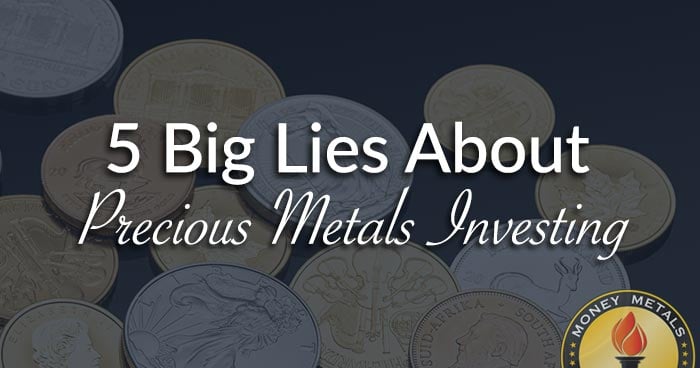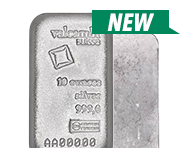Physical precious metals serve a unique role in an investment portfolio. Unlike stocks and bonds, gold and silver bullion can be held entirely outside of the financial system. They carry zero counterparty risk and represent wealth in tangible form.
Unfortunately, investors must often navigate through a barrage of fake news, myths, misinformation, and fraudulent pitches surrounding precious metals before arriving at the simple truth.
You don’t buy bullion to get rich quickly. You buy it to preserve wealth over time against the threats of currency depreciation and financial crisis.
Opting for common, low-premium bullion products that sell close to spot prices is the most efficient way to invest.
That’s precious metals investing in a nutshell. But if you listen to financial and monetary establishment mouthpieces, you’ll likely be misled.
Lie #1: Gold Isn’t Money
Neither brokers, bankers, nor central bankers particularly want the investing public to view precious metals as a core holding. They prefer we think of gold as a “barbarous relic” of the past that no longer serves as money.
In an infamous exchange in 2011 between then Federal Reserve Chairman Ben Bernanke and pro-gold Congressman Ron Paul, Bernanke stated flatly that gold is “not money.” Current Fed Chairman Powell has made similar claims.
This is the big lie of fiat money pushers and their ideological allies.
It flies not only in the face of history but also in the fact that central bankers themselves continue to hold and accumulate gold as monetary reserves. In recent years, central banks around the world, led by Russia and China, added hundreds of tons of gold to their reserves.
Lie #2: Silver Isn’t Money
Some misinformers will concede that gold is money… but claim silver isn’t.
The Founding Fathers of the United States would disagree strongly. They originally defined a “dollar” in terms of grains of silver (Coinage Act of 1792) which simply codified what was nearly universally in practice.
Specifically, a dollar was to be 371.25 grains (equivalent to about three-fourths of an ounce) of silver, in harmony with the Spanish milled dollar.
Thus, the true foundation for U.S. circulating currency was silver.
It’s true that silver has since been removed from circulating coins and replaced with cheaper metals.
It’s also true that silver generally isn’t held in monetary reserves by central banks.
Silver, however, remains the go-to tangible money of the masses. In the event of a currency collapse that causes the public to ditch fiat dollars, silver is more likely than gold to be used as barter money in everyday transactions.
Lie #3: Precious Metals Are Too Risky for the Typical Investor
This lie is propagated by Wall Street and by Main Street financial advisors who have bought into anti-gold propaganda.
Their conflict of interest is obvious. The financial industry loses out on commissions and fees when investors park wealth in hard assets. So they portray gold and silver as “exotic” and “risky” investments.
It would indeed be risky to bet everything on gold and silver. But no responsible voices in the precious metals community advocate that for the typical investor.
Instead, they advocate a prudent allocation to the precious metals sector – from around 10%, perhaps up to 25% of a portfolio.
Gold shows virtually no correlation to stocks and bonds, meaning it can rise when paper assets fall.
When the U.S. suffers a debt-driven currency crisis, as many economic forecasters think is inevitable, the biggest risk of all will be not having adequate exposure to precious metals.
Lie #4: Cryptocurrency Is More Valuable Than Hard Currency
The crypto coin craze has spawned a number of misconceptions, such as the notion that Bitcoin is “digital gold.” Whatever their merits (and there are certainly some), cryptocurrencies backed only by digits cannot be equated to gold and will never replace it.
Unfortunately, some cryptocurrency promoters are trying to sell their digital storylines by bashing gold.
Grayscale Investments, which runs an exchange-traded Bitcoin product, produced an anti-gold TV commercial on CNBC portraying gold buyers as “living in the past” and out of step with the “digital world.” The commercial’s narrator states, “Digital currencies like Bitcoin are the future… and unlike gold, they actually have utility.”
The lie that gold lacks utility is an old one propagated by the financial establishment. It’s now being regurgitated by overzealous Bitcoin bugs.
The truth is that gold came to be recognized as money precisely because it has utility outside of monetary use. Gold is useful not just to jewelers and artisans, but also to rocket scientists in space technology applications.
Bitcoin has speculative value, which can be fleeting.
Gold’s value, on the other hand, is real, immutable, and eternal. Its unique physical properties combined with its rarity ensure it will always be worth something substantial.
Lie #5: “Collectible” Coins Are Better Investments than Bullion Coins
Sadly, some of the misinformation being spread about gold and silver investing comes from bad actors within the precious metals industry.
The biggest culprits are numismatic coin promoters who try to trick people into paying huge markups for supposedly “rare” or “collectible” coins.
High-pressure salesmen will sometimes pitch nonsense about numismatics being “confiscation proof” or fantasies about how they’ll appreciate more than ordinary coins.
They almost certainly won’t after factoring in bid/ask spreads. The truth is that these high-premium and relatively illiquid products are unsuitable for the vast majority of investors who are simply looking to acquire ounces of gold and silver. Common, low-premium bullion products are the better buy.

About the Author:
Stefan Gleason is CEO of Money Metals Exchange, the company recently named "Best Overall Online Precious Metals Dealer" by Investopedia. A graduate of the University of Florida, Gleason is a seasoned business leader, investor, political strategist, and grassroots activist. Gleason has frequently appeared on national television networks such as CNN, FoxNews, and CNBC and in hundreds of publications such as the Wall Street Journal, TheStreet, and Seeking Alpha.






